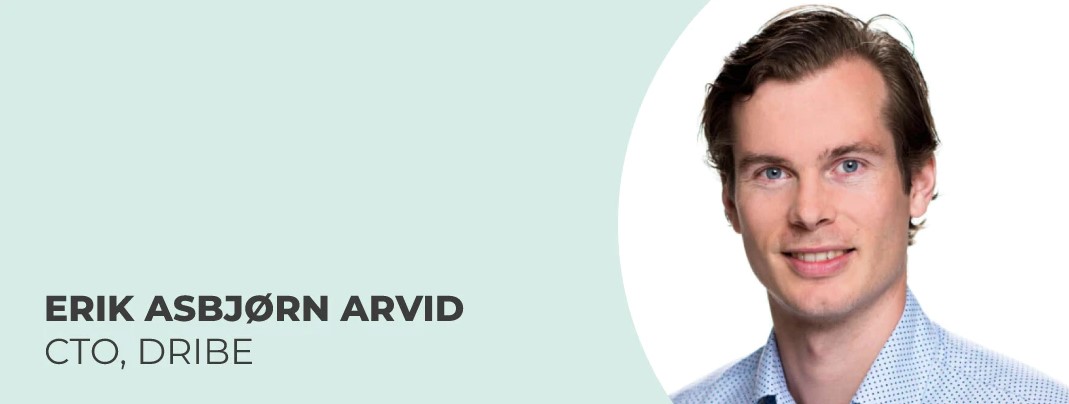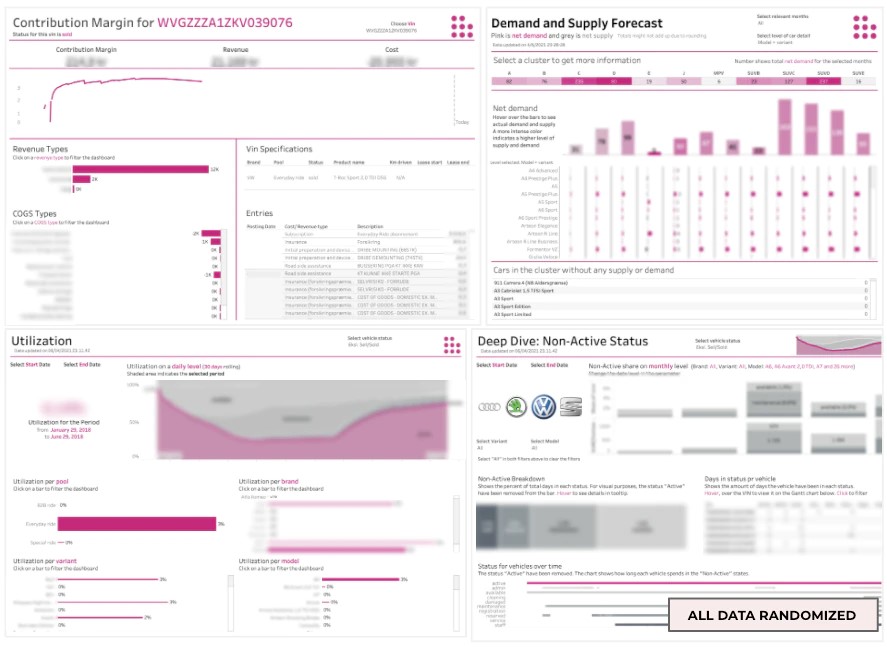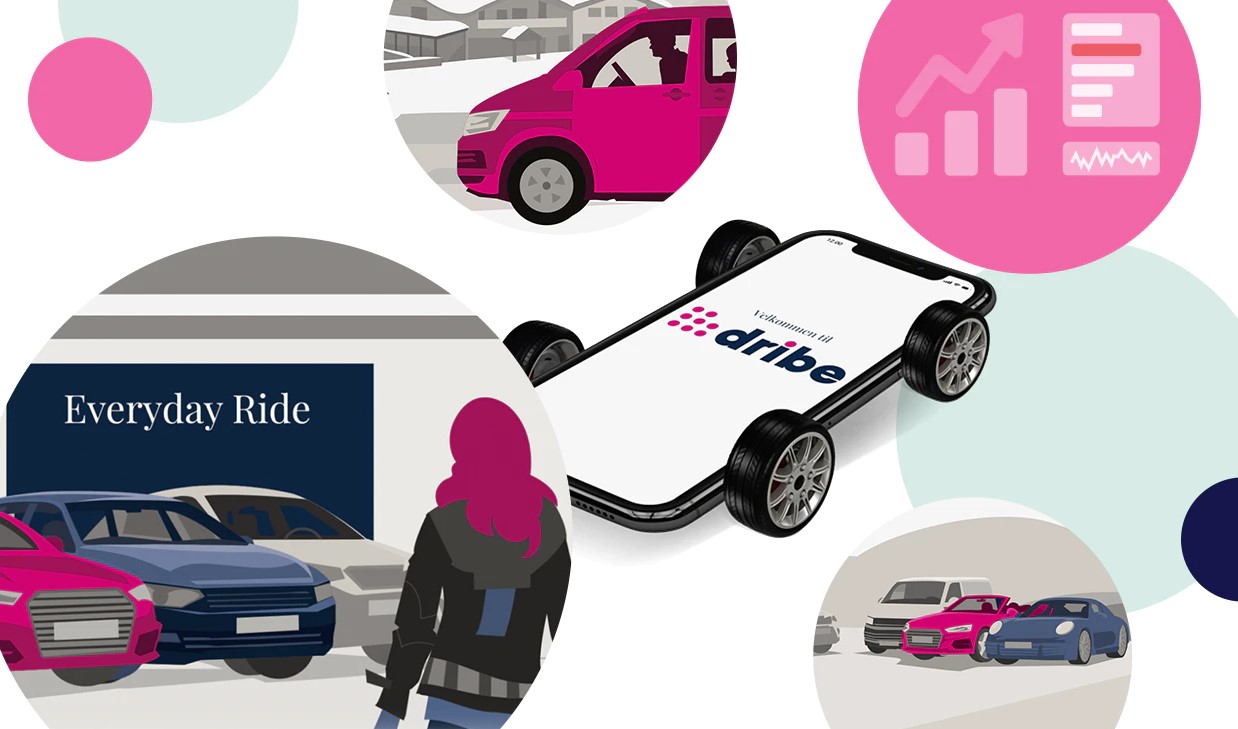Creating a truly scalable business requires maximum utilization of data and automation.
Dribe sell car subscriptions, but they run on data
The Danish company Dribe are in the middle of a small revolution on the Danish market for short term leasing and “car subscriptions”. As a customer with Dribe you get access to a wide range of cars and you are free to choose a new one every month – or temporarily swap your ride. For example by upgrading to a luxury car for special occasions, get a van when you’ve got stuff to move, or get a more spacious vehicle for family trips or extended weekends. It’s all 100% digitalized and with Dribe’s app the customer has total control over when and how often they want to swap their cars.
Data is an indispensable part of the product. Our business is centered around data and we have built it into our processes from day one
Dribe is a young company with a fairly low number of employees – but they have a lot cars to manage. Every month up to 200 customers swap their cars. Each interaction generates a new price point, new registration of the vehicle’s location, condition and much more. That amounts to more than 100.000 new lines of data added to Dribe’s systems every day. And for each new customer the numbers grow.
The only reason it is possible for Dribe to scale their company is by setting up systems that help them manage this data and prevent them from drowning in it.

Erik Asbjørn Arvid is CTO of Dribe and always on the look-out for technologies that can strengthen Dribe and increase the scalability of the business.
It’s only possible thanks to data
“Data is an indispensable part of the product. Our business is centered around data and we have built it into our processes from day one”, says Erik Asbjørn Arvid, CTO of Dribe.
In close collaboration with Inviso by Devoteam, Dribe have built a solid and versatile data-setup for their organisation with Alteryx software as the core pillar. All the data points generated by the customers actions are stored in Alteryx, and from there the data is utilized across the entire organisation. It’s used in Dribe’s app to provide customers with a constant overview of available vehicles, and it’s used in internal dashboards that enable the management to always be on top of the numbers and the most current state of the business.
Additionally, the data core has a sophisticated layer of automation built into it that triggers actions and events.
“We have decided to go all-in on automation. We believe it is the only way for us. The combination of data and automation is the reason our business can exist – and the reason that it can scale. From the get-go we have built all our systems so they can handle very large volumes of data and transactions”, says Erik Asbjørn Arvid.

With Dribe the customers have a car subscription and can choose to swap their cars anytime they want to. The entire process is automated and all interactions happens through Dribes app.
With the combination of these three dashboards we always have a precise overview of what cars the customers are actually demanding and how we can meet that demand in a manner that is profitable for us
3 ways Dribe use data and automation
This automation of data runs through all parts of Dribe. Here are three examples of what they have done:
#1 Pick up a new ride 24/7 – data fueled self service
As a customer with Dribe you can swap your car when you want to. A few pushes on the app releases a code that you can bring to the garage and use to open the door and drive out again. Sounds easy right? Well it is easy – for the customers at least.
Inside Dribe’s systems each change of car generates a chain of automated processes that runs through the Alteryx core that registers the order, generates a code for the customer, sends it out via SMS, and informs the cameras at the garage to open for the specific licence plate. And it’s all synchronized to the sales and CRM system.
It’s a setup that gives both a stand-out customer experience and at the same time is highly efficient for Dribe.
#2 Automated Finance department
When it comes to internal processes, automation is also at the heart of the matter. One example of this is Dribe’s finance department that runs with a minimal amount of human interaction. Instead, a sophisticated web of workflows (in Alteryx) automatically pulls in transactions from Stripe (Dribe’s payment solution), records transactions in the ERP and reconciles them with the bank and Stripe.
“Previously we used to sit down once a month and do the books by hand, with all that entails of risks of manual errors”, says Erik Asbjørn Arvid – “Now it’s all handled by the system. Faster and without errors”.
This fully automated finance setup allows Dribe to scale their business and take on a high number of new customers, with having to increase the headcount in their administration at the same rate.
#3 Visualizing the fleet of the future
A third example of Dribe’s use of data is their visualizations in dashboards built in Tableau that are constantly updated with live data. These dashboards provide transparency and insights into Dribe’s business performance, allowing the management to make better decisions based on the most recent facts and numbers.
Among the +40 Tableau-dashboards that display information from the data-core are predictions about future sales, profitability calculations for each vehicle type, car status data pulled from the sensors in the cars, overviews of which cars are booked, when they are booked and much more.
Three of the main dashboards show utilization, contribution margin and expected future demand/supply of specific models. These dashboards make up a highly important tool for the company enabling the management to optimize the business. E.g. which new types of cars to bring in to the fleet and which to phase out. This ensures that Dribe always have the cars that customers want – when and where they want them.
“With the combination of these three dashboards we always have a precise overview of what cars the customers are actually demanding and how we can meet that demand in a manner that is profitable for us”, says Erik Asbjørn Arvid.

A small sample of Dribe’s more than 40 Tableau dashboards updating every 20 minutes with data from 11 different sources. All data is randomized in the screenshots above.
Dribe’s data setup is built in close collaboration with Inviso by Devoteam. Erik Asbjørn Arvid says:
“Our collaboration with Inviso by Devoteam has been essential for us to be able to built a company with data at the core. I all phases their combination of hands-on data expertise and strategic business demands has helped us take our business to another level. Their consultants are both highly skilled and nice to work with. That makes it possible to reach the results we have reached”.
How to get started with data in your organisation
Inviso by Devoteam helps all types of organisations turn data into business. No matter if you are just getting started or have a data foundation created already, we can’t wait to help. Contact us directly or use the form below to hear what we can do for your business.

